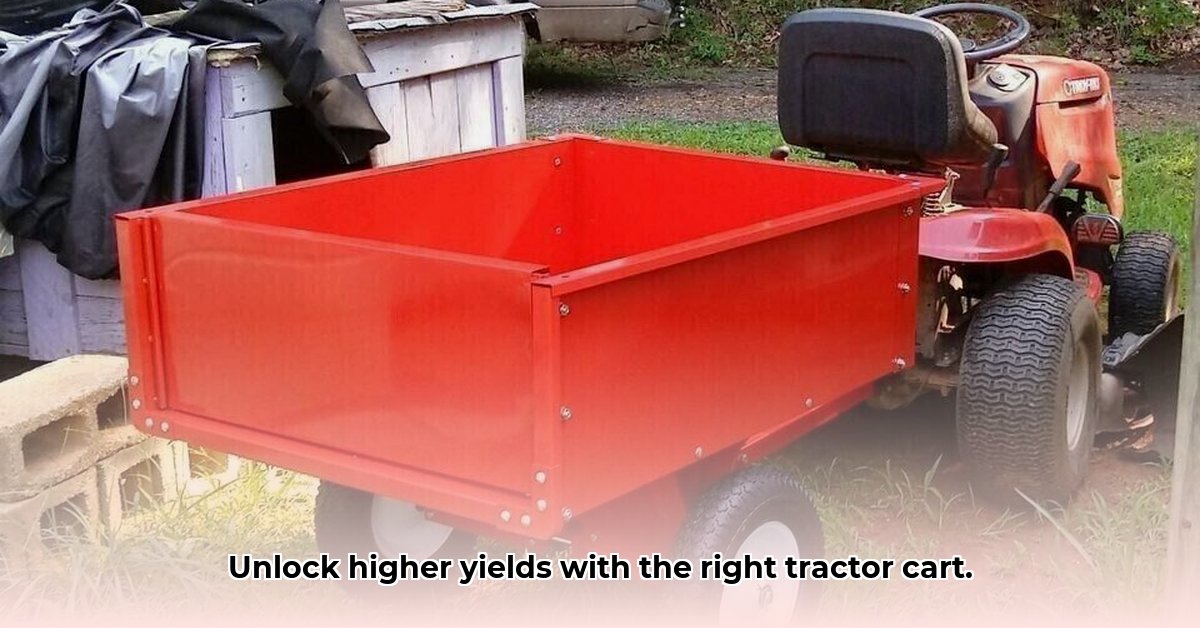
Tractor Carts: Revolutionizing Sustainable Agriculture
Farming is demanding. Back-breaking labor, soil compaction, and the pressure for higher yields while protecting the environment create significant challenges. But what if a simple solution could ease this burden? A well-chosen tractor cart can dramatically improve efficiency and sustainability on any farm. This guide provides actionable insights into selecting, using, and maintaining a cart perfectly suited to your sustainable farming practices. For more information on specialized tractor carts, check out these helpful resources.
Picking the Perfect Tractor Cart: A Tailored Approach
Choosing the right tractor cart requires careful consideration. It's not just about finding a cart—it's about finding the perfect tool for your specific needs. A well-matched cart significantly boosts efficiency and minimizes environmental impact.
1. Types of Tractor Carts: The ideal cart depends on its primary function. Heavy-duty carts are necessary for hauling large harvests, while smaller, maneuverable carts suffice for lighter loads. Specialized carts with attachments for tilling, seeding, or spraying offer increased versatility. Consider what tasks your cart will perform most frequently.
2. Material Selection: Prioritize sustainable materials. Recycled steel offers exceptional durability and a lower environmental footprint than new steel. Locally sourced, sustainably harvested wood is another eco-friendly option, provided it receives appropriate treatment. The entire lifecycle—from production to disposal—should be evaluated.
3. Size and Capacity: Cart size directly impacts efficiency. An oversized cart is cumbersome on a small farm, while an undersized cart risks overloading and damage. Assess your farm's size, crop types, and typical loads to determine the optimal capacity. Don't underestimate the importance of a proper size match.
4. Attachment Options: Maximize your cart's functionality with attachments. Tilling, seeding, and spraying attachments transform your cart into a multi-purpose tool, significantly enhancing efficiency and reducing the need for multiple pieces of equipment. Think of the additional value these attachments offer.
Maximizing Your Tractor Cart's Efficiency and Sustainability
Once you've chosen your cart, proper usage is crucial for maximizing its benefits.
1. Regular Maintenance: Regular inspections are essential. Check bolts, lubricate moving parts, and address any wear and tear promptly. This extends the cart's life and prevents costly breakdowns. Proactive maintenance prevents significant problems.
2. Weight Distribution: Even weight distribution prevents damage to the cart and your tractor. Overloading leads to increased fuel consumption and reduces equipment lifespan. Proper loading techniques are crucial for safety and efficiency.
3. Safety Precautions: Prioritize safety. Always wear appropriate safety gear, maintain good visibility, and follow the manufacturer's safety guidelines. Preventing accidents ensures your well-being and preserves your investment.
The Environmental Footprint of Your Tractor Cart
Sustainability extends beyond your crops to your equipment.
1. Manufacturing Impact: The manufacturing process significantly affects your cart's carbon footprint. Recycled steel carts have much lower emissions than those made from new steel. Consider the environmental cost of production.
2. Fuel Efficiency: Choose a cart designed to minimize drag and optimize your tractor's horsepower. This reduces fuel consumption, lowering both operating costs and environmental impact. Fuel efficiency directly impacts your expenses and carbon footprint.
3. Responsible Disposal: Plan for your cart's end-of-life. Explore recycling options for components to reduce waste. Responsible disposal practices are paramount for sustainability.
Emerging Trends in Sustainable Tractor Cart Technology
The future of sustainable farming includes innovative cart technology.
1. Electric Tractor Carts: Electric carts are gaining traction, offering zero tailpipe emissions and quieter operation. This trend reduces reliance on fossil fuels.
2. Smart Attachments: GPS-guided attachments for seeding and spraying offer precision resource management, minimizing waste and maximizing yield. Innovation leads to greater efficiency.
The Economics of Sustainable Farming: Is a Tractor Cart Worth It?
While the initial investment may seem substantial, the long-term benefits often outweigh the cost. Reduced labor, increased efficiency, and environmental benefits contribute to a significant return on investment. The long-term savings in labor far outweigh the initial cost.
Dr. Anya Sharma, Agricultural Engineer, University of California, Davis: "Investing in sustainable farm mechanization, like a thoughtfully chosen tractor cart, offers significant long-term economic and environmental benefits for smallholder farmers. The improved efficiency and reduced labor costs contribute directly to increased profitability and a reduced carbon footprint."
Conclusion: Investing in a Sustainable Future
Choosing a tractor cart is an investment in your farm's future and a healthier planet. Careful consideration of the factors in this guide will help you select a cart that supports sustainable and efficient farming practices. By embracing these principles, you're not just improving your farm's output—you're contributing to a more environmentally responsible future.